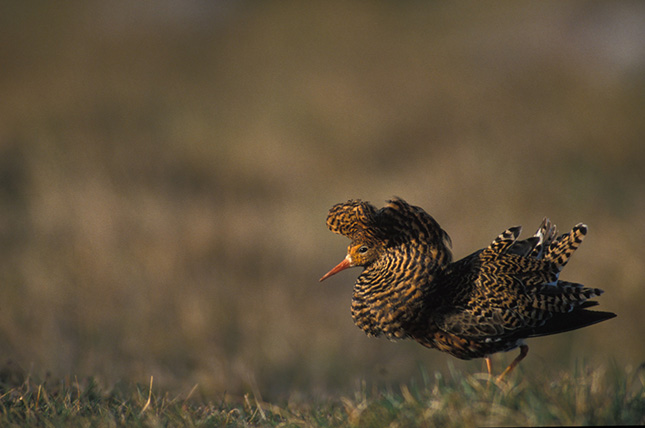Texas A&M Researchers and International Collaboration Identify a ‘Supergene’ Underlying Genetic Differences in Testosterone Levels and Sexual Behavior in Male Ruff

COLLEGE STATION, Texas – The ruff is a Eurasian shorebird that has a spectacular “lekking” behavior where highly ornamented males gather in a single location and compete for females. Now two groups, one led by researchers at the Texas A&M University College of Veterinary Medicine & Biomedical Sciences (CVM) and Uppsala University, report that males with alternative reproductive strategies carry a chromosomal rearrangement that has been maintained as a balanced genetic polymorphism, leading to three types of ruff males, for about 4 million years. The two studies are published today in Nature Genetics.
Three different types of ruff males occur at the leks of this species. Independent males show colorful ruffs and head tufts and fight vigorously for territories. Satellite males are slightly smaller than Independents, do not defend territories and have white ruffs and head tufts. Faeder is the third body type, or morph; these are disguised males that mimic females by their small size and lack of ornamental feathers. The Independent and Satellite males show a remarkable interaction, where the Satellite males allow Independent males to dominate them on the leks.
“Both Independents and Satellites benefit from the interaction because it increases their mating success by attracting females that are ready to mate,” explained Dr. Fredrik Widemo, who did his Ph.D. on ruff lekking behavior. Widemo also noted that fighting over territories and females is both energetically costly and risky. This created an opportunity for the evolution of alternative male mating strategies in which males spend less energy on fighting.
Previous studies have indicated that these remarkable differences between male morphs are under strict genetic control and are determined by a single genetic region. These most recent studies represent an explanation for how such complex differences in behavior, size, and plumage have a simple genetic basis. To arrive at the answer, the research teams sequenced the entire ruff genome.
“This is a fascinating study that exemplifies the power of modern genomics to unravel a seemingly complex behavioral and morphological phenotype. Surprisingly the alternative male morphs found in the ruff are the product of a single, yet strongly differentiated locus that was dramatically altered in just a few million years. The authors provide an additional illustration of the increasing role that structural mutations play in evolution and disease,” said Dr. William Murphy, professor in the department of Veterinary Integrative Biosciences at the CVM.
“We discovered that both Satellite and Faeder males carry a ‘supergene,’ which is not a gene with superpower but a cluster of about 90 genes kept together by a chromosomal inversion indicating that there is no genetic exchange between the three different morphs,” said Sangeet Lamichhaney, one of the PhD students involved in the study, “The simple answer is that the ‘supergene’ contains both genes like HSD17B2 affecting the metabolism of sex hormones and the MC1R gene controlling pigmentation.”
The group reports that the sequence difference between the chromosome variants is as large as 1.4 percent-higher than the average sequence difference between human and chimpanzee chromosomes. The scientists estimate that the chromosome inversion happened about 4 million years ago.
“The Satellite and Faeder male morphs are the result of an evolutionary process over million of years and involve many genetic changes among the 90 genes in this ‘supergene,'” explained Dr. Leif Andersson, who led the study at Uppsala University and also served as a Texas A&M; Institute for Advanced Study fellow. “The ‘supergene’ contains five genes that have a role in the metabolism of steroid hormones. It is particularly interesting that we see an enrichment of genetic changes in the vicinity of a gene, HSD17B2, which determines an enzyme that converts active testosterone to a more inactive form. Independents have a significantly higher level of testosterone than Satellite and Faeder males, and we think this is the reason that in turn leads to an altered behavior.”
There are many examples of associations between behavior and pigmentation in animals, but the underlying causal relationships have rarely been revealed. The present study now provides insights into why there is such a strong association between altered behavior and white color in Satellite males.
“We think that this evolutionary process started with the occurrence of the inversion about 4 million years ago and that the inversion in itself altered the regulation of one or more genes affecting the metabolism of sex hormones,” added Andersson. “This created a primitive alternative male morph, which has been further improved step by step by the accumulation of many genetic changes.”
“Nature has certainly ‘experimented’ a lot on sex determination, sexual development, and reproduction,” said Terje Raudsepp, associate professor in the Department of Veterinary Integrative Biosciences (VIBS) at the CVM, “but only excellent research and researchers can reveal its full beauty and complexity. I applaud the researchers for this fascinating discovery-and also ruff Faeder males for their effortless reproductive success.”
“Dr. Andersson has a distinguished history of elegant discoveries in the field of genetics and evolution,” said Dr. Evelyn Tiffany-Castiglioni, professor and VIBS department head. “This is an example of his creative, non-invasive way of unraveling how a species has evolved successfully by maintaining males with diverse behaviors and appearances.”


